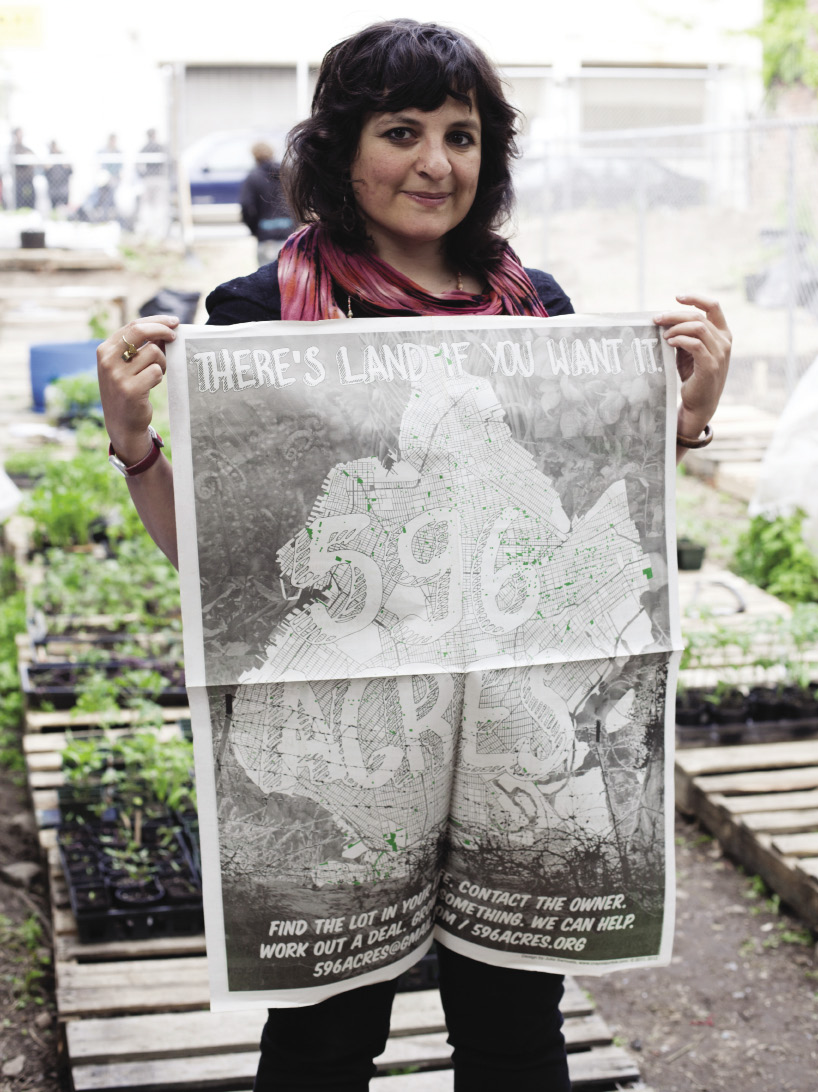For decades, New Yorkers working to transform empty lots into verdant gardens have relied on shovels and wheelbarrows. But Paula Segal—a 34-year-old lawyer with a penchant for driving community cohesion—has found breathtakingly powerful gardening tools in the form of interactive maps and a well-designed flowchart.
Armed with those—and an eye for agricultural opportunity—Segal created 596 Acres, an organization that connects would-be gardeners with vacant city-owned lots. She says founding the group was “sort of a total accident,” born of her frustration over a sprawling two-acre wasteland across from her home on Myrtle and Kent. Twenty-five years ago, the city had promised the Bed-Stuy site would become a neighborhood park—a plan long since forgotten by elected officials. Fed up with the rat’s nest of weeds and litter, Segal organized a public meeting at a local high school to see if there was any neighborhood interest in cleaning up the old lot. When 100 people showed up, she realized she had struck a chord. Everyone was game to get gardening, but nobody knew how to gain city permission.
After a little digging—the figurative kind—she unearthed a staggering statistic: Vacant city-owned lots in Brooklyn total a whopping 596 acres. Taken together, this area—which does not include privately owned vacant lots—is larger than Prospect Park. “When I got the data back from the city,” Segal said, “it was a pretty shocking figure.”
The path to vacancy is varied. Some lots were intended as neighborhood development projects but fell into decrepitude after funding for construction dried up. Others—especially those in lower-income neighborhoods—were meant to become affordable private housing units, but New York City’s Department of Housing Preservation and Development often meets with reluctance from banks, and the lots can sit empty for years.
For Segal it was a double discovery: She realized just how many empty lots dot Brooklyn—and just how much bureaucratic confusion keeps communities from turning them into garden plots.
So Segal joined forces with computer programmer Eric Brelsford to build an interactive online map of all city-owned vacant lots in Brooklyn. The site allows users to search, zoom ing in on specific lots; post notes about ideas, organization and progress; and connect with other interested community members. As for what to do once you’ve identified a spot and fellow gardeners—Segal worked with an illustrator to develop a smart, well-designed flowchart that’s basically a one-page roadmap for navigating city agencies in order to gain land access. These tools are at 596acres.org, but Segal also posts flowchart printouts at vacant lots. “We’re trying to reach people who look at the world digitally and those who hang out on their stoop,” she said. After hanging the illustration at an abandoned lot, she usually hears from gung-ho gardeners within 24 hours. In just nine months, 596 Acres has already helped three groups gain official access to abandoned lots—and at least 25 others have begun the process.
Last fall, Tom Hallaran clicked around on the site and zoomed in on adjacent abandoned sites in Boerum Hill. “Looking for others interested in turning these three lots, which have been vacant since at least the 1970s, into a garden for the community,” he posted. “Please don’t hesitate to contact me if you’re interested—we can work together.”
Through the message board, Hallaran soon connected with a neighbor, Tami Johnson, who was interested in creating a community garden. Segal’s resources helped the new friends identify the lots’ permissions contact, and together they waded through the paperwork and bureaucracy. It worked: By December, they were granted permission to garden there.
Hallaran named his project Feedback Farms, now comprised of four young Brooklynites united by their love of kale, while in the lot next door Johnson created A Small Green Patch, a community garden that partners with the Textile Arts Center and St. Lydia’s.
Feedback Farms has big plans for multiple locations, but for now they’re busy on Bergen Street, pulling weeds, installing portable planters and figuring out ways to outsmart the local squash-eating squirrels. By midsummer they plan to be picking a dozen varieties each of tomatoes and peppers, plus eggplants and specialty greens, which they’ve lined up to sell to a new restaurant in Gowanus called Runner & Stone. But they know they can only grow until they get the heave-ho—which is part of why they’ve planted in subirrigated containers, rather than city soil itself. If need be, the crew can simply pick up their sprouts and move. “We’re a mobile operation,” said Feedback’s Kallie Weinkle.
Segal delights in seeing what her initiative has fostered. “One thing that’s interesting is a lot of folks we’ve reached are not gardeners, they’ve never thought about these things before,” she said. “They’re confronting a whole system of challenges together, which is difficult but also exciting.” She has plans to roll out data for other boroughs.
Technology got these gardeners together—and in the same spirit, Feedback Farms is growing food not just with sunshine and rain, but with gadgetry too. They’re investigating a wireless moisture- and temperature-monitoring network that will alert the urban farmers via Twitter or texts when a particular crop needs attention, and will be collecting constant streams of data to maximize crop yields. Segal must be proud.
Photo credit: Elizabeth Lietzell



